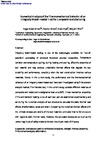Numerical analysis of the thermomechanical behaviour of an integrally water-heated tool for composite manufacturing
| dc.contributor.author | Abdalrahman, R | |
| dc.contributor.author | Grove, S | |
| dc.contributor.author | Kyte, Adam | |
| dc.contributor.author | Rizvi, MJ | |
| dc.date.accessioned | 2018-10-12T11:49:37Z | |
| dc.date.available | 2018-10-12T11:49:37Z | |
| dc.date.issued | 2017-02 | |
| dc.identifier.issn | 0731-6844 | |
| dc.identifier.issn | 1530-7964 | |
| dc.identifier.uri | http://hdl.handle.net/10026.1/12489 | |
| dc.description.abstract |
<jats:p> Integrally water-heated tooling is one of the technologies available for ‘out-of-autoclave’ processing of advanced thermoset polymer composites. Temperature variation and temperature cycling, during heating and cooling, affect the properties of tool material and may produce undesirable thermal effects that degrade the tool durability and performance, especially when the tool construction involves various materials. Hence, in the current study, the performance and the thermomechanical behaviour of an integrally water-heated tool have been investigated using finite element analysis method. The intended tool, in the current study, consists different materials of composite and metals and is designed to heat up to 90℃. Linear mechanical properties, coefficient of thermal expansions and transient heating curve of each tool part are determined experimentally and set during the numerical analysis of tool structure to calculate the static thermal load effects of deformation, stress and strain. Comparing the numerical thermal effects with the ultimate stresses and strains of the tool, materials concluded that no failure occurs with regard to static thermal loads. However, the calculated stresses are as much as the lowest magnitude of safety relates to the tool mould part made of Alepoxy. </jats:p> | |
| dc.format.extent | 241-253 | |
| dc.language | en | |
| dc.language.iso | en | |
| dc.publisher | SAGE Publications | |
| dc.subject | Composite | |
| dc.subject | integrally water-heated tool | |
| dc.subject | finite element analysis | |
| dc.subject | deformation | |
| dc.title | Numerical analysis of the thermomechanical behaviour of an integrally water-heated tool for composite manufacturing | |
| dc.type | journal-article | |
| dc.type | Journal Article | |
| plymouth.author-url | https://www.webofscience.com/api/gateway?GWVersion=2&SrcApp=PARTNER_APP&SrcAuth=LinksAMR&KeyUT=WOS:000400151800001&DestLinkType=FullRecord&DestApp=ALL_WOS&UsrCustomerID=11bb513d99f797142bcfeffcc58ea008 | |
| plymouth.issue | 4 | |
| plymouth.volume | 36 | |
| plymouth.publication-status | Published | |
| plymouth.journal | Journal of Reinforced Plastics and Composites | |
| dc.identifier.doi | 10.1177/0731684416681502 | |
| plymouth.organisational-group | /Plymouth | |
| plymouth.organisational-group | /Plymouth/Faculty of Science and Engineering | |
| plymouth.organisational-group | /Plymouth/REF 2021 Researchers by UoA | |
| plymouth.organisational-group | /Plymouth/REF 2021 Researchers by UoA/UoA12 Engineering | |
| plymouth.organisational-group | /Plymouth/Users by role | |
| plymouth.organisational-group | /Plymouth/Users by role/Academics | |
| plymouth.organisational-group | /Plymouth/Users by role/Researchers in ResearchFish submission | |
| dcterms.dateAccepted | 2016-11-03 | |
| dc.identifier.eissn | 1530-7964 | |
| dc.rights.embargoperiod | Not known | |
| rioxxterms.versionofrecord | 10.1177/0731684416681502 | |
| rioxxterms.licenseref.uri | http://www.rioxx.net/licenses/all-rights-reserved | |
| rioxxterms.licenseref.startdate | 2017-02 | |
| rioxxterms.type | Journal Article/Review |


